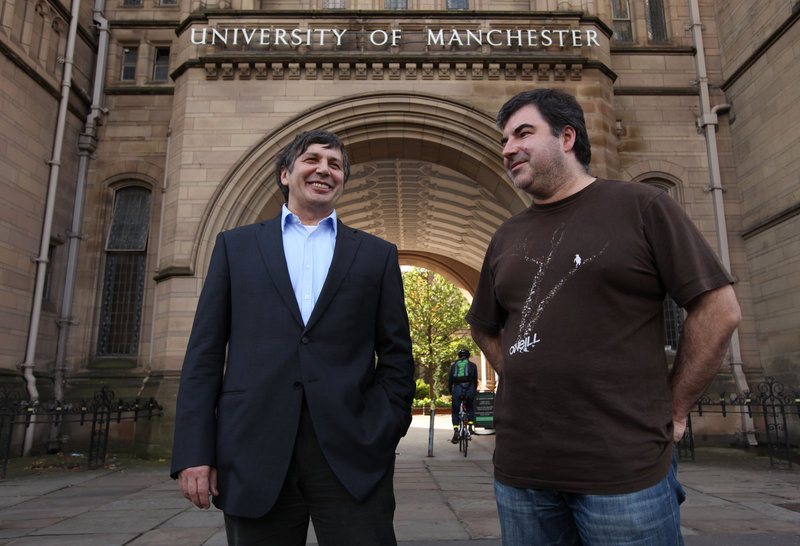NEW YORK — It is the thinnest and strongest material known to man – no thicker than a single atom and 100 times tougher than steel. Could graphene be the next plastic? Maybe so, says one of two scientists who won a Nobel Prize on Tuesday for isolating and studying it.
Faster computers, lighter airplanes, transparent touch screens – the list of potential uses runs on. Some scientists say we can’t even imagine what kinds of products might be possible with the substance, which hides in ordinary pencil lead and first was extracted using a piece of Scotch tape.
Two Russian-born researchers shared the $1.5 million physics Nobel for their groundbreaking experiments with graphene, which is a sheet of carbon atoms joined together in a pattern that resembles chicken wire.
Andre Geim and Konstantin Novoselov of the University of Manchester in England used Scotch tape to rip off flakes of graphene from a chunk of graphite, the stuff of pencil leads. That achievement, reported in 2004, opened the door to studying what scientists say should be a versatile building block for electronics and strong materials.
“It has all the potential to change your life in the same way that plastics did,” said Geim, 51, a Dutch citizen.
MIT chemist Michael Strano said, “We can’t even imagine the uses we’re going to find.”
But he and others have some ideas. Graphene’s electrical properties mean it might make for faster transistors, key components of electronic circuits, and so lead to better computers, the Nobel committee says. As a single layer of carbon atoms, it’s tiny, which could pay off in more powerful cell phones, several scientists said.
And since it’s practically transparent, it could lead to see-through touch screens and maybe solar cells, the committee says. It might also pay off for big TV screens.
Its tremendous strength could produce composite materials that are super-strong and lightweight, for use in airplanes, cars and satellites, the panel says.
So why aren’t pencil leads super-strong, if they contain graphene? Breaking a lead generally involves a shearing off between graphene sheets rather than breaking the sheets themselves, explained James Tour of Rice University. And while a person can tear up a single sheet of graphene, it’s still stronger than a one-atom-thick sheet of anything else.
“There’s nothing stronger,” Tour said.
Graphene has not made its mark in ordinary consumer products yet, although some prototype electronic display screens and composite materials have been created, Strano said.
Researchers are trying to find a practical way to make large quantities of pure graphene, something more amenable to large-scale use than the Scotch-tape approach, Strano said.
Send questions/comments to the editors.



Success. Please wait for the page to reload. If the page does not reload within 5 seconds, please refresh the page.
Enter your email and password to access comments.
Hi, to comment on stories you must . This profile is in addition to your subscription and website login.
Already have a commenting profile? .
Invalid username/password.
Please check your email to confirm and complete your registration.
Only subscribers are eligible to post comments. Please subscribe or login first for digital access. Here’s why.
Use the form below to reset your password. When you've submitted your account email, we will send an email with a reset code.